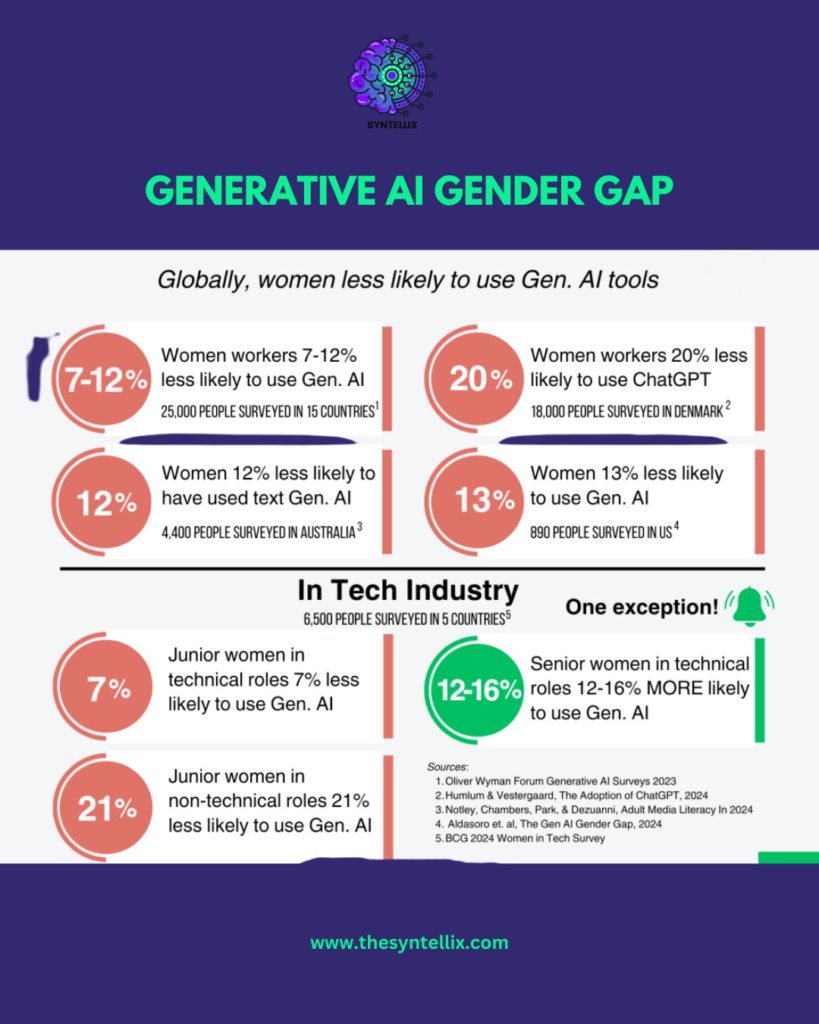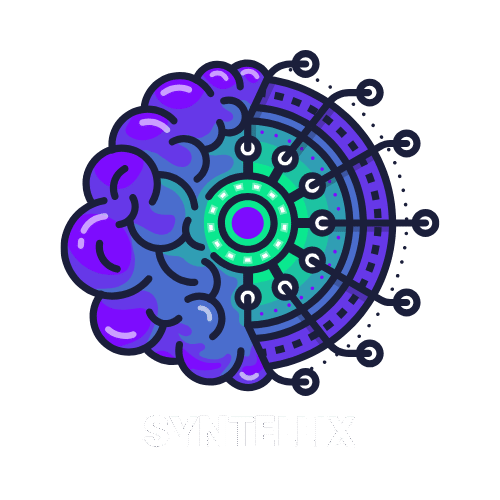Table of Contents
ToggleYou might face the situation when you use the AI tool to create content for your business, but the results may include outdated gender stereotypes. Why does this happen? Because the AI learned from data that wasn’t diverse, picking up the same biases as the people who created it.
When there’s a lack of diversity in the people who are building generative AI, it can lead to tools that are unfair or leave people out.
In this blog post, we’ll talk about why diversity is so important in generative AI, how the gender gap affects the technology, and what we can do to make AI more fair and inclusive. Let’s get started!
What is gen ai gender gap in simple words
The Generative or gen AI gender gap refers to the imbalance between men and women (and other underrepresented groups) in the development, training, and impact of generative AI systems like AI tools that create text, images, or code.
You might see this gender gap into two ways:
- Lack of diversity among creators: Most of the people who are designing and training AI models are men, especially in their technical roles. This means that women and marginalized groups are often missing during training phase. When these categories are not the part of the process, the gen AI tools may not properly justify each gender role fairly.
- Bias in AI outputs: As you know, generative AI is trained on huge datasets from the internet (which often include stereotypes or biased content), it can unintentionally repeat or even amplify gender stereotypes in the content it creates. For example, it might show a man as a doctor and a woman as a nurse by default, simply because that pattern appeared more in its training data.
In simple terms, the gen AI gender gap means that if we don’t include more diverse voices in AI development and clean up biased data we are taking risk in building technology that leaves people out or treats them unfairly. Closing this gap is essential to making AI tools more accurate, respectful, and useful for everyone.

Global Evidence On Gender Gaps And Generative AI
Researchers found a consistent gender gap in the adoption of generative AI tools like ChatGPT and Claude. By examining data from 18 studies and over 140,000 users worldwide, they discovered women use these tools about 20% less often than men.
This gap persisted even after equal access was provided, and showed up across different regions, jobs, and education levels.
The gap matters because if generative AI systems are trained mostly on male users, they could become less accurate and less beneficial for women. The study suggests that more than equal access such as boosting confidence, offering training, and changing cultural attitudes is necessary to close the gap and ensure AI benefits everyone.
Source: Harvard Business School.
Why does the gen ai gender gap exist?
The gender gap in generative AI exists mainly because fewer women and marginalized groups are involved in building and training these systems.
Most AI models learn from large amounts of online data like websites, books, and social media and much of that data reflects society’s existing biases, including gender stereotypes.
Also, the tech industry itself still struggles with diversity. Women and non-binary individuals are underrepresented in AI research and development roles, so their perspectives are often missing when decisions are made about how AI should work. This means the systems often don’t reflect everyone equally.
In short, the gender gap in generative AI is a mix of biased training data and a lack of diverse voices shaping the technology. Fixing this requires both better data and more inclusive teams.
Why diversity matters in Generative AI
Diversity matters in Generative AI because it helps to create technology that is fair, accurate, and works well for everyone not just a few groups of people.
Generative AI learns from the data it’s trained on. If that data mostly comes from one group like people from one country, gender, or culture the AI will reflect only their views, language, and way of thinking. That means the AI might unintentionally ignore or misrepresent other people’s experiences, especially those from minority or underrepresented groups.
For example, if an AI model is trained mostly on text written by men, it might struggle to represent women’s perspectives. If it learns from mostly Western sources, it may misunderstand people from Asia, Africa, or Latin America. This can lead to biased content, stereotypes, or even offensive outputs.
But when we include people of different genders, cultures, languages, and backgrounds in the development process, the AI becomes more balanced. It understands a wider range of viewpoints and generates content that is more inclusive and respectful of everyone.
In short, diversity helps generative AI to become more human-like not just in how it writes or speaks, but in how fairly and wisely it treats people. It’s not just the right thing to do—it also makes the technology smarter, safer, and more useful for everyone.
Initiatives to promote diversity in Generative AI
The good news is that there are many initiatives working to close the gender gap in generative AI. Here are a few examples:
1. Educational programs
Organizations like AI4ALL and Girls Who Code provide AI education and mentorship for underrepresented groups, helping to inspire the next generation of diverse AI professionals.
2. Corporate initiatives
Companies like Google and Microsoft are investing in programs to support women in AI. For example, Google “Women in AI” initiative focuses on increasing female representation in AI research and development.
3. Advocacy groups
Groups like Women in Machine Learning (WiML) and Black in AI provide networking opportunities, resources, and support for underrepresented groups in the AI community.
4. Policy changes
Governments and organizations are beginning to push for gender quotas and inclusive hiring practices to ensure that AI teams reflect the diversity of the populations they serve.
Tips for creating inclusive Generative AI systems
If you’re working in generative AI, here are five actionable steps you can take to promote diversity and inclusion:
1. Build diverse teams
Ensure your team includes people of different genders, ethnicities, and backgrounds. Diversity isn’t just a checkbox—it’s a necessity for creating fair and effective AI systems.
2. Conduct Bias audits
Regularly test your generative AI systems for bias and fairness. Use diverse datasets and involve diverse teams in the testing process.
3. Use inclusive data
Make sure your training datasets are representative of the populations your AI system will serve. This is especially important in areas like language models and creative tools.
4. Develop ethical guidelines
Create and follow ethical AI frameworks that prioritize inclusion and fairness. Make these guidelines a core part of your development process.
5. Provide mentorship and support
Offer mentorship programs and resources for underrepresented groups in AI. Encourage women and minorities to pursue careers in AI and provide the support they need to succeed.
The future of diversity in Generative AI
The gender gap in generative AI is a complex issue, but it’s not insurmountable. While progress has been slow, there are signs of change:
- More women are entering AI and tech fields than ever before.
- Companies and governments are beginning to prioritize diversity and inclusion.
- Advocacy groups are raising awareness and pushing for systemic change.
But there’s still a long way to go. Closing the gender gap in generative AI will require ongoing effort, collaboration, and commitment from all of us.
Conclusion: Why diversity matters in gen ai gender gap
The gen ai gender gap isn’t just a problem for women—it’s a problem for everyone. When AI systems are designed by homogenous teams, they’re more likely to be biased, exclusionary, and ineffective.
By promoting diversity and inclusion in generative AI, we can create systems that are fairer, more innovative, and better equipped to serve all of humanity. The future of AI depends on the voices we include today.
What do you think about the gen ai gender gap? Have you experienced its impact firsthand? Share your thoughts in the comments below—we’d love to hear from you!
Visit my website for my AI ETHICS news! THE SYNTELLIX.
People Also Ask
What percentage of AI is female?
AI itself does not have a gender, but when referring to gender representation in the AI workforce, women are significantly underrepresented. As of 2025, studies show that only around 22% to 26% of AI and data science roles are held by women globally. This gap is even wider in technical and leadership positions.
What are the gender issues with AI?
Gender issues in AI include bias in training data, underrepresentation of women in AI development, and the frequent design of AI systems that reflect societal stereotypes. For example, virtual assistants are often assigned female voices and roles, reinforcing traditional gender norms. Additionally, algorithms trained on biased data can result in discriminatory outcomes in areas like hiring, healthcare, and facial recognition.
Which gender uses AI the most?
There is no definitive global data on AI usage by gender, but usage tends to reflect broader tech access and digital behavior trends. In general, men are slightly more likely to adopt and experiment with emerging technologies, including AI tools, especially in professional and technical settings. However, this gap is narrowing as AI becomes more consumer-friendly and widely integrated across industries.
What does gen AI struggle with?
Generative AI (Gen AI) struggles with several challenges, including bias, hallucinations (producing false or misleading information), lack of true understanding, and context limitations. It also inherits and amplifies biases present in its training data, which includes gender, racial, and cultural stereotypes. Additionally, Gen AI often lacks ethical reasoning, making it risky in high-stakes decisions without proper oversight.
Stay ahead of the curve with the latest insights, tips, and trends in AI, technology, and innovation.

